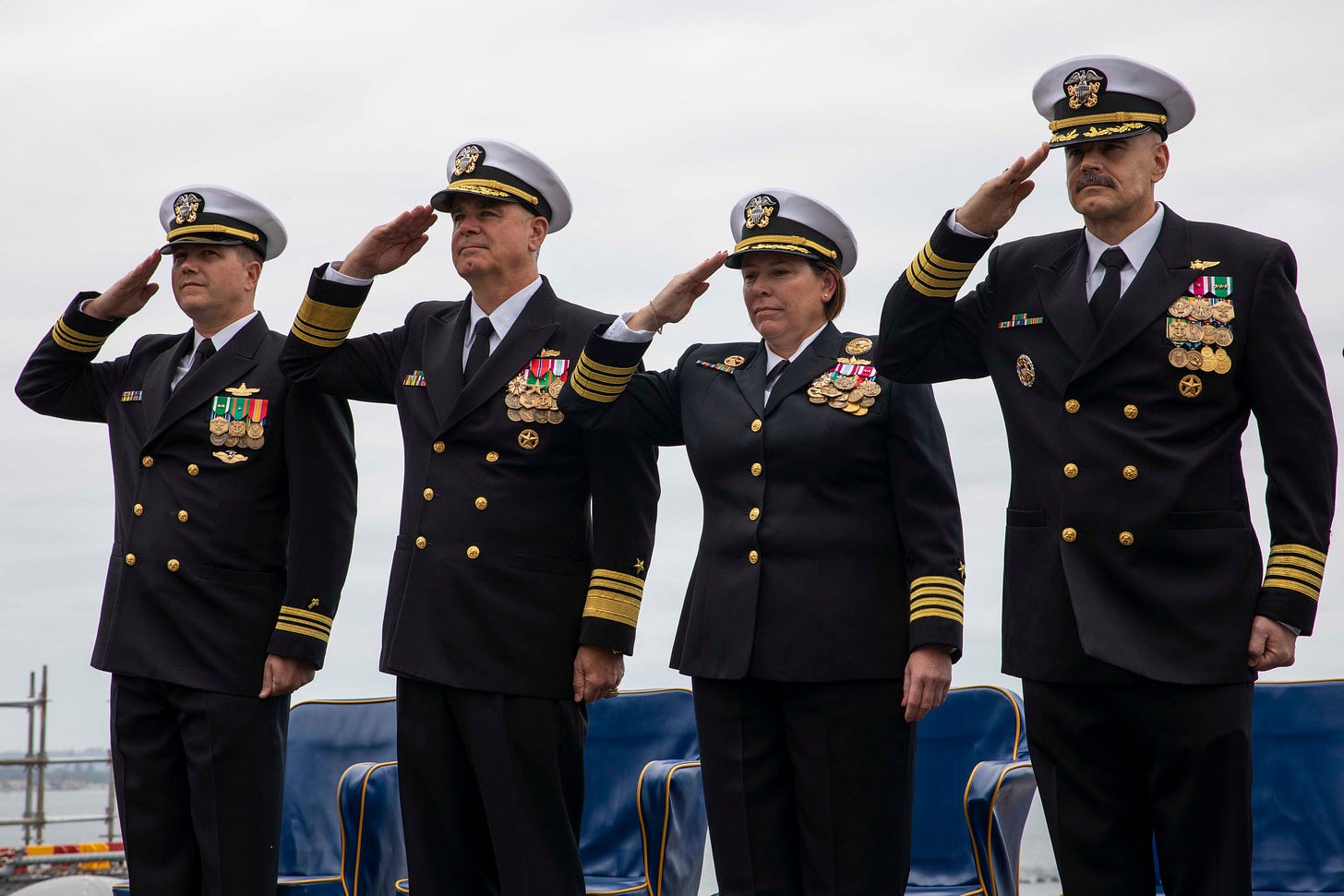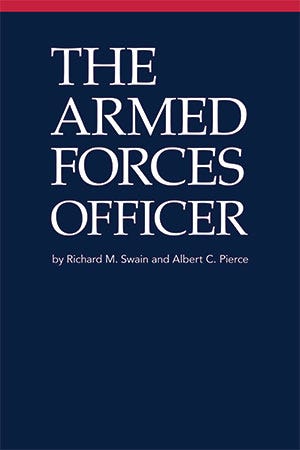Note: Much of what I’ve written thus far and shared with you here has focused on the intersection of social science, philosophy, and, to some extent, theology as they pertain to how we humans navigate the hardship and uncertainty of life. That will continue.
Another important part of how we navigate a certain segment of life’s crucibles involves how we conceptualize, operate, and interact with the military.
Why? One reason is that a lack of safety and security is one way in which life for every person can become highly uncertain and dangerous. Another reason is that a professional military—properly construed, organized, and operated—ensures the freedom and supports the well-being of its nation’s people. As such, I argue that understanding what being a military officer is about matters for all of us—both for military members (officers and enlisted) and civilians.
In a ten-part series, I will be unpacking a variety of core ideas regarding the American idea of being an armed forces officer, following the book The Armed Forces Officer by Richard Swain and Albert Pierce (one of the many books I included on my October 2024 list of reading suggestions that I provided to my military teammates, which you can download at the end of this piece). I intend to intersperse these pieces over the course of a few months; some weeks I may post something from the series and other weeks I may return to the regularly scheduled programming.
Below is part 1 of 10. Because I’m an American, the information and observations I share here are from that perspective. Newcomers to my work may find it contextually relevant to know that I’m a senior officer in the U.S. Navy. But as always, these are my views, and they do not necessarily represent the views of the U.S. Department of Defense or its components.
Introduction
In the United States (and much of the world), people in the military are generally either enlisted personnel or commissioned officers. Although they’re both critical parts of the same team, these two groups are unique in terms of what they do and the conditions under which they serve.
Enlisted Personnel
The backbone of the military’s workforce is its enlisted personnel, who function as experts in a wide variety of technical areas. In the U.S. Navy, those areas range from electricians to photographers, from weapons specialists to logisticians and everything in between. It’s really quite a wide array of specialties, many of which require a great deal of specialized training.
Enlisted personnel comprise the vast majority of the uniformed members of the military, across which they deploy their deep areas of necessary expertise. According to data from 2023, the average ratio of enlisted to officer personnel across all branches was 4.4 enlisted members for every officer for active duty forces and 4.6 enlisted members for every officer in the reserve forces. So if you look at the whole U.S. military, that’s about 81.8 percent enlisted personnel and 18.2 percent officers.
Enlisted personnel enter into specific contracts with the U.S. government via periods of enlistment. Typically, these are for four years but can vary from two to eight years under various circumstances.
Upon enlistment, service members take the following Oath of Enlistment:
I, (state your name), do solemnly swear that I will support and defend the Constitution of the United States against all enemies, foreign and domestic; that I will bear true faith and allegiance to the same; and that I will obey the orders of the President of the United States and the orders of the officers appointed over me, according to regulations and the Uniform Code of Military Justice. So help me God.
Note that in this oath, the person first pledges loyalty and commitment to the Constitution of the United States but then also pledges obedience to the orders of superiors and to the orders specified by various codes and regulations.
Commissioned Officers
Officers generally serve in leadership positions and typically are required to have a four-year college degree. In the Navy, they serve as aviators, in leadership aboard ships and submarines, in special operations, and in a variety of technical fields including but not limited to medicine, public affairs, legal, human resources, intelligence, logistics, and engineering to name a few.
Instead of entering into an enlistment contract, officers typically serve a minimum obligation of eight years, some of which is on active duty with the rest being as part of the reserve component. The actual amount of time an officer must spend on active duty often varies their commissioning source, which makes sense: If the government pays for you to go to the United States Naval Academy, for example, then spending at least five years on active duty afterward is a fair trade (in my view).
New officers take the following Oath of Office:
I, (state your name), do solemnly swear that I will support and defend the Constitution of the United States against all enemies, foreign and domestic, that I will bear true faith and allegiance to the same; that I take this obligation freely, without any mental reservation or purpose of evasion; and that I will well and faithfully discharge the duties of the office upon which I am about to enter. So help me God.
Note that this oath, like the Oath of Enlistment, pledges one to support and defend the Constitution of the United States. In contrast to the Oath of Enlistment, however, it says nothing about obedience to superiors nor to any other codes or regulations. That’s not to say that junior officers aren’t expected to follow orders given by superiors or to adhere to various policies and regulations, but in terms of the oath, it’s to the Constitution alone.

The Commission and the Oath
The first chapter of The Armed Forces Officer delves into the ideas and substance surrounding both the commission and the oath for armed forces officers, stating:
The commission and the oath constitute an individual moral commitment and common ethical instruction. They legitimize the officer’s trade and provide the basis of the shared ethic of commissioned leadership that binds the American military into an effective and loyal fighting force. They are the foundation of the trust safely placed in the Armed Forces by the American people. (p. 1)
The basics go something like this:
The Constitution gives the president the power to commission military officers.
The president, and by extension the rest of the nation, place a special trust and confidence in those officers.
Just as subordinates are required (and oath-bound) to follow the orders of superiors, officers are also required to follow orders and directions from their superiors who are “acting in accordance with the laws of the United States of America.”
Officers, therefore, must act within the confines of the law.
And all of that is essential for building and maintaining trust.
Although the success of the United States military stems from many sources including its trained personnel and advanced technology, its true source of strength comes from the trust it has built with the American people. The commission conveys a set of expectations upon military officers, expectations that they must consistently meet in order to maintain that web of trust that extends to them from the public.
Those expectations include patriotism, valor, fidelity, and abilities. Military officers should have a devotion to their country, courage and fortitude in the face of danger, faithfulness to the Constitution and to those they lead, and the competence they need to succeed in their tasks and responsibilities. Without those, trust can begin to erode, which can lead to a host of grave issues.
Turning to the oath, Swain and Pierce highlight in The Armed Forces Officer how it coincides with and complements in a way the commission. The commission depends upon the oath, which is a freely taken, public, and individual commitment. The oath is an explicit commitment to the Constitution; it is also an implicit commitment to the judicious use of force despite adverse and dangerous conditions. Swain and Pierce write:
Officers’ particular duty, or at least that which defines their corps, is the leadership and direction of men and women in the disciplined use of lethal force (or the threat thereof), in the pursuit of purposes sanctioned by the state and legal under the Constitution and in international law. (p. 6)
Stemming from the special nature of an officer’s commission and oath, there’s a element of “otherness” that comes with being a military officer. Swain and Pierce put it plainly, “Commissioned officers are intentionally different” (p. 6).
What this looks like in practicality is that military officers in the United States (and many other countries) are a separate group within the broader military. Such differences include superficial markings such as uniforms and insignia, but they extend to various deep traditions and even deeper to sets of responsibility and authority.
It doesn’t take a social scientist to notice many cultural artifacts that indicate such “otherness,” which extends to manners of speech (e.g., officers being referred to as “sir” or “ma’am”), salutes, and various other markers of respect for officers’ position and duties. Officers are not to have unduly familiar relationships with enlisted personnel—not because of some differential in fundamental matters of human dignity and respect but due to matters of professionalism and the maintenance of good order and discipline within military units.
All of these customs and regulations may seem unnecessary or even archaic to some, but they exist for good reasons. Most notably, they exist to maintain the faith and trust that the American people have for its military organizations. Swain and Pierce put it this way:
Society’s respect for the professional officer is conditioned on reliable, effective, honorable, and efficient performance of duty … What the American people expect from their Armed Forces, and trust that they will receive, is reliable, effective, honorable, and efficient service, whenever, wherever, and in whatever form the government of the day decides is necessary. The guarantee of that service is internalization in every officer of the expectations embodied in the commission and the oath: patriotism, valor, fidelity, and abilities; dedication to the protection of the letter of and the values embodied in the Constitution; and a willingness to offer, if required, what President Lincoln called “the last full measure of devotion” in its defense. (pp. 8-10)
Summary
In the United States, the military’s strength depends upon the trust placed in it by the government and the American people. That trust, however, must continually be earned and maintained through military officers living up to the the promises of their oaths as they fulfill the expectations of their commissions. Without that trust, the military institution erodes and society eventually suffers.
Military officers are duty-bound to remember these key tenets and live them. And the American public should know them as well so as to understand its military forces and the expectations that its members must uphold.
References and for further reading
All of my current posts about The Armed Forces Officer
The Armed Forces Officer by Richard M. Swain and Albert C. Pierce. Click here to download the book for free from National Defense University Press.
The Declaration of Independence
The Constitution of the United States
Code of Conduct for Members of the United States Armed Forces
Military Community Demographics: Click here for various reports and dashboards
Join the Navy! Click here for information




